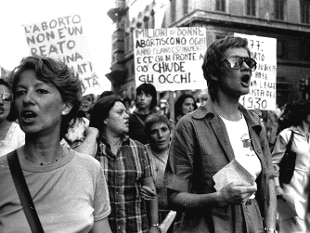- "We are not mares", the flash mob in Milan for the 40 years of Law 194 in the Handsmaid Tale style
- Legalization of abortion in Italy, the images of the long march
- Shock poster against abortion on a building in Rome
- "Abortion is femicide", clash on pro life posters
- Abortion, Council of Europe: too difficult in Italy. Violated the right to health
Share
May 22, 2018 May22, 1978. After years of bitter social, ethical and political battles, law 194, the one that recognizes the right of women to voluntarily terminate pregnancy, is approved. Before then, abortion was considered a crime by the Italian penal code. In the front line in support of women and their right to abortion, the left-wing parties (PCI, PSI, PSDI), the liberal-capitalist parties (Pri, Pli) and the Italian Radical Party.
History
The story of 194 starts from afar. It was 1971 when the Constitutional Court declared article 553 of the Criminal Code, which recognized the propaganda of contraceptives as a crime, illegitimate. In the same year, the first bill for the termination of pregnancy was presented. The initiative starts from the socialist senators Banfi, Caleffi and Fenoaltea. The same year, another project was presented to the Chamber by a socialist exponent. Neither is ever discussed.
It will take three years for the waters to move. Coinciding with the Lateran Pacts, the socialist Loris Fortuna (the first signatory of a bill for the legalization of divorce) presents a new bill, supported by the Radicals and the Women's Liberation Movement.
On February 18, 1975, following an appeal, the Constitutional Court declares art. 546 of the Criminal Code (Abortion of a consenting woman): the legitimacy of the therapeutic abortion was recognized.
On April 29, 1975, Parliament approved law 405 for the establishment of family counseling centers, which have as their objectives the disclosure of contraceptives.
In the following years there will be six abortion laws proposed by the Italian Communist Party, Liberali, the Italian Democratic Socialist Party, the Women's Liberation Movement and Christian Democracy.
On 22 May 1978 the bill proposed by the left-wing, liberal-capitalist and radical parties was approved.
After two years, on May 17, 1981, the Catholic Life Movement thinks about proposing its abolition through an abrogative referendum. The controversy arising from the initiative ignited. Italy itself splits in two. But in the end 68% of Italians said they were against the repeal.
Before then women were forced to practice abortion clandestinely. Many deaths from infections caused by improvised "interventions". And of course the discrimination was the social class of belonging and the economic availability: Those who had the opportunity allowed themselves the "luxury" of turning to the so-called "golden spoons", those who lacked them, to the "mammane".
Data: Abortions decrease in Italy
From the official data reported by the Ministry of Health in 2017 on the implementation of law 194, it is clear that Italian women choose to abort more and more rarely.
In 2016 there were 84,926 voluntary terminations of pregnancy, a number more than halved compared to the 234,801 counted in 1982 (the year in which there was the largest number of abortions in Italy). From 1982 to today, the reduction has been 74.7%, going from 234,801 abortions to 59,423 in 2016.
In particular, the abortion rate among minors falls: 3.1 per thousand, a very low percentage compared to European peers.
Another alarming figure emerges from the report: 70% is the percentage of objecting doctors in Italy. The largest number of objectors is found in Basilicata. One of the highest percentages internationally: In Great Britain the rate drops to 10%, in France to 7%, in Gemania to 6% and in Sweden to 0%.
"We are not mares", the flash mob in Milan in Handsmaid Tale style
In Milan the fortieth anniversary of the approval of law 194 regulating the voluntary termination of pregnancy was celebrated by the feminist network "Non Una Di Meno" with a flash mob and a procession from Piazza del Duomo to the Mangiagalli Clinic characterized by the red color of the tunics and the white headdresses inspired by the "Tale of the handmaid" by Margaret Atwood from which a popular television series, "The Handmaid's Tale" was
recently taken #LiberaDiSchoose: read the news and watch the video

